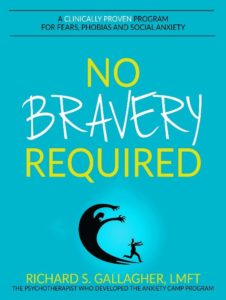 As a monthly contributing blogger for CarolRoth.com who is approaching my five-year anniversary soon, I am entitled to one shameless plug every few years. The first came in 2013 when my book The Customer Service Survival Kit (featuring a foreword by Carol) launched and eventually hit #1 in customer service – and taught thousands of people how to handle their very worst customer situations.
As a monthly contributing blogger for CarolRoth.com who is approaching my five-year anniversary soon, I am entitled to one shameless plug every few years. The first came in 2013 when my book The Customer Service Survival Kit (featuring a foreword by Carol) launched and eventually hit #1 in customer service – and taught thousands of people how to handle their very worst customer situations.
Today, I’m back with a new book from my “day job” as a practicing psychotherapist, on a subject that is near and dear to my heart: getting fear out of your life. I specialize in treating anxiety disorders such as fears and phobias, and have watched people from all walks of life learn to soar when they successfully lose these often-crippling fears. And when you run a small business, fear can have very real consequences for your livelihood as well as your peace of mind.
My new book No Bravery Required: A Clinically Proven Program for Fears, Phobias and Social Anxiety borrows from nearly a decade of running Anxiety Camp, an intensive group program for anxiety sufferers and their families, as well as treating literally hundreds of clients with very good outcomes. Its title is also its key point: losing your fears involves skills, not bravery. Here are some of the key ones if anxiety has become one of your biggest business partners:
Develop mindful awareness. All day long, you think scary thoughts. “I’m not going to be able to meet next month’s payroll! My employees are miserable to work with! How am I going to keep up with the competition?” The first step in shrinking these fears down to size is to learn to observe rather than emotionally react to these thoughts.
Picture yourself sitting in a comfortable chair, with these thoughts playing on a movie screen. Let them come and go as they please, and compassionately observe them. (“Interesting – I’m playing the old “woe is me” clip, followed by my usual “I’m doomed” story.”) Then shift your attention to your senses and your breathing, and realize that you are warm, safe, dry – and here. Stay with this moment, and realize that this moment is OK, and the next moment probably will be, too.
Change the narrative. When you are afraid, you talk to yourself using language you would never use with someone you love. Often you shame and frighten yourself, and descend into helplessness. And here’s how you change this: write these thoughts down on paper, then rewrite them to turn them from helplessness into action.
For example, turn “I can’t deal with Sally” to “Here is how Sally predictably reacts, and here is what I will say to her.” Turn “My cash flow is hopeless” to “Here is my game plan for boosting receivables this month.”
And perhaps above all, turn “I’m worried about failure” to “Here are the resources and choices I have in front of me.” Make it your script, starring you!
Learn to be fully present with what you fear – in small steps. Whether you are afraid of spiders or confrontation with coworkers, the real key to losing a fear is to approach it in small steps, and learn to be fully present at each step. For example, start by looking at a picture of a spider, or asking your horrible coworker a small favor. Then work your way up from there.
Instead of mentally clenching your teeth, holding your breath or distracting yourself, take in the sights, sounds and thoughts of where you are and what you are doing.
The real key? Keep the steps so small and lame that you keep practicing. After a surprisingly small number of these steps, more often than not, your perspective starts to change and the fear starts to crumble.
There is sometimes more to it than these basics, of course. Sometimes I’ve done role-playing exercises with people to safely practice scary social situations, or taken field trips with people to places they fear.
Having good “outs” for scary situations is important, too. And sometimes specific skills are the key – for example, I once developed a handout called “Conversation 101” to teach people with social anxiety how to have a nourishing 5-7 minute conversation with anyone, using simple procedural techniques.
Either way, the basics of losing your fears remain the same: start observing your thoughts, change your language to give yourself more choice and control, and learn to be fully present as you take really small, lame steps toward whatever it is you fear. No bravery required!
Editor’s note: If you (or someone you know) is dealing with anxiety, go buy a copy of Rich’s book here.

